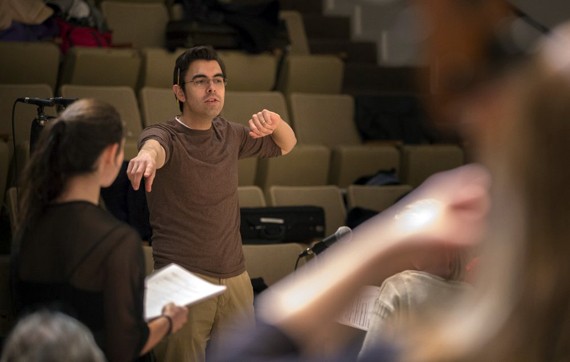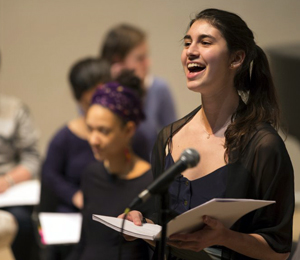Watch: South Pacific Performances Mark and Reflect Sesquicentennial

When Andrew Hauze '04 discusses the golden age of musical theater, his eyes light up.
Ever since childhood, he's been steeped in it. The unforgettable characters. The social commentary. The soaring melodies. The orchestra's unmistakable sweep.
"It's infectious," says Hauze, conductor of the College orchestra. "You can't help but be captivated by these fantastic orchestrations, which present a wonderful training ground for young singers, players, and conductors."
Hauze and like-minded music majors longed to bring that to Swarthmore. So when they began brainstorming about how to mark the College's sesquicentennial musically, Hauze had an idea - a concert performance of the Rodgers and Hammerstein classic South Pacific, adapted from the Pulitzer Prize-winning book Tales of the South Pacific by James Michener '29.
Historical in nature and socially progressive, South Pacific reflects the spirit of Swarthmore and its sesquicentennial.
"It all just clicked," Hauze says. "Here you have one of our most prominent alums, who carried our name out into the world and made this interesting impact on musical theater in the 1940s."
Hauze pitched the idea to Maurice Eldridge '61, vice president for college and community relations and sesquicentennial committee chair, who had enjoyed the 2008 Broadway revival of South Pacific. Critics and audiences marveled at the power of its 30-person orchestra, a rarity these days, and the enduring relevance of its message.

By performing South Pacific in concert, the College will focus on its musical and literary aspects. Hauze intends to spotlight the orchestra - half of which is performing, matching the Broadway revival - and avoid "completely overtaking the students' lives."
The show features current and former faculty and staff members as well as local children, but its cast and chorus are mostly students. To spark their interest, Hauze provided an array of materials on the show, from books and recordings to secondary literature.
"It's emblematic of how the College does things as a whole and the way we do things in the music department," he says, "trying to wholly engage with a text or a piece of music or a work of art."
Still, Hauze faced an obstacle: selling a 1940s production to students largely unfamiliar with the style. He had cultural and generational gaps to bridge.
"I feared that they would just rebel against it, saying 'This is old-fashioned,' or 'This isn't me,'" he says. "But that hasn't been the case at all. They're throwing themselves into it with great aplomb."
"The fact that it's a period show is immediately clear, in the music, dialogue, everything," says Laura Katz '16, from New York City, who portrays Nellie Forbush, a navy nurse from rural Arkansas. "And I think that's a lot of fun!"
There have been some eye rolls and laughter for especially dated dialogue, Hauze says. But that levity fostered learning.
"It's exciting to essentially enter another time and try to understand why the character would have said that," Hauze says. "It's a great exercise, if a bit jarring at first to try on those clothes."
Also jarring are some of the characterizations in the show, which confronts racial and cultural conflicts during World War II. While Hauze and students cite some as "problematic" if taken out of context, they also extoll their value.
"The show raises themes that are highly pertinent to modern day life," says its co-conductor, Jeremy Rapaport-Stein '14, a music and political science major from Princeton Junction, N.J. "The nuanced exploration of tolerance and intolerance endows the show with an engaging, timeless quality."
Rapaport-Stein shares music direction duties with Audrey Edelstein '15, a music major from Manhasset, N.Y. They will rotate leadership of different numbers for each performance.
"That's atypical for us conductors, who tend to have big egos," Hauze says. "But it's also very Swarthmorian - intensely collaborative."
"Audrey and I have a really beneficial and supportive creative relationship that's been crucial to my work on the show," agree Rapaport-Stein, "which kept me from going crazy more than once."
Reflecting on weeks of rehearsals, Hauze notes the participants' energy and "earnest desire to treat every element of the show with integrity and artistry." He's eager to present the show to the College community, touting its appeal to not just those who can whistle "Some Enchanted Evening" but newbies in search of a good time.
"It's a near-perfect blending of the material in terms of music, lyrics, and drama," he says. "To see that come together can't help but be fun. Plus, it's free!"

Performances will be held Sat., Feb. 15, at 8 p.m. and Sun., Feb. 16, at 7:30 p.m. in Lang Concert Hall. No tickets or reservations are required. A faculty panel exploring the political and cultural history of South Pacific will precede the Saturday performance at 7 p.m. For more information, call 610-690-3489 or email: ConcertManager@swarthmore.edu.